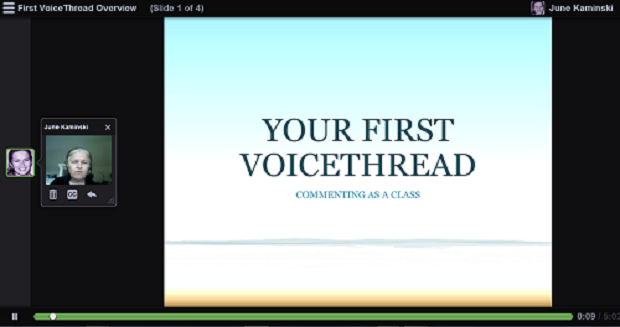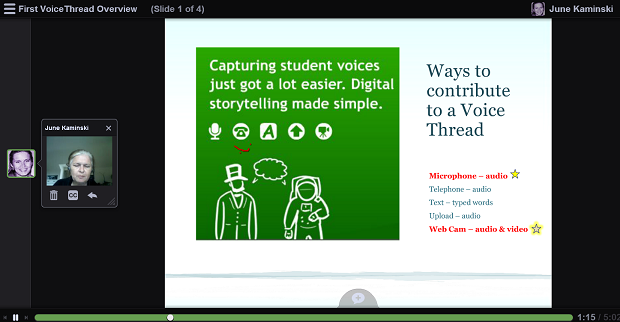by June Kaminski, RN MSN PhD(c)
The challenge
Nursing education is slowly moving towards hybrid/blended (partially online) as well as fully online courses. One of the biggest challenges in making the online components of these courses meaningful is how to easily support interactivity and establish a sense of presence. VoiceThread is a very accessible and high-performing tool that helps educators meet these challenges.
A solution
Software like VoiceThread can be used in nursing courses to promote multi-sensory ways to respond and reflect on course content (including audio, video, and text). “A VoiceThread is a collaborative, multimedia slide show in which viewers navigate through the slides and leave comments. The comments can be left in five ways: using voice (with a telephone or a computer’s microphone), typing text, uploading an audio file, or creating video via a webcam” (Siegle, 2011, p. 56). In the nursing program I help to lead, the VoiceThread assignments are clustered via Moodle within each course so students can access and contribute to each course’s VoiceThreads as part of a collective experience. “So an entire classroom of students can collectively analyse a media text on a single page, share fresh perspectives, challenge each other’s thinking and develop greater understandings in the process” (Rodesiler, 2010).
The benefits
Nursing students can dialogue, reflect, analyze, present, and give feedback using VoiceThread. As students respond to assignments and comments left by other students, they practice expressive presentation and communication skills as they reflectively respond with voice or video recordings (Pecot-Hebert, 2012; Gillis Luthin, Parette & Blum, 2012). The student engagement supported by these interactive tools adds a rich layer of social interaction and a sense of community (Kaminski, 2014).
Students can also use VoiceThread as a medium for project-based assignments. Most students find the web-based software easy to use and a great way to combine talking with seeing and informing. As well, mobile apps are available for both Android and Apple mobile devices including tablets and smartphones. Students find it easy to comment on VoiceThread assignments using their mobile devices and can do so from practically anywhere.
How to get Started
The easiest way for nursing faculty to begin to use VoiceThread (https://voicethread.com/) is to design an eye-catching, brief PowerPoint slideshow of relevant directives and images (include a title slide with course information on it so students can easily locate it, especially if you create a collection of them for a course). Save the PowerPoint as a pdf and upload it to a VoiceThread account. If your institution has a VoiceThread license, this can be done right through the learning management system. If they do not, you can purchase a license for a single class of 50 students for $99 a year.

Figure 1 shows an example of a PowerPoint title page
Figure 1 shows an example of a PowerPoint title page with the author’s comment box to the left. As students add their comments to the assignment, their avatar and comments are installed in the left and right hand columns. The software automatically plays through the series of comments in the order they are left. You can also isolate and hone in on a particular comment as needed. Comments can be left on any of the slides within the assignment, thus the software supports multiple interaction points throughout the range of slides (Figure 2).

Figure 2: You can interact at multiple points
As you get more experienced, you can experiment with other types of files: simple images, Word or pdf documents, even videos you have created. VoiceThread also has a whiteboard function where you can select different types of pens from its built-in palette and draw on or highlight the uploaded documents you have selected to showcase in your VoiceThread production. If you are looking for an easy way to enhance presence, interaction, and collaboration in your online classes, I encourage you to try VoiceThread. I predict you and your students will find it to be both easy and enriching to use.
To find out more visit:
The Official VoiceThread website at: https://voicethread.com/
The VoiceThread Youtube channel at: https://www.youtube.com/channel/UCXggZ2yUPudu9EKx5ZtrdAw
References
Gillis, A., Luthin, K., Parette, H. P., & Blum, C. (2012). Using “VoiceThread” to Create Meaningful Receptive and Expressive Learning Activities for Young Children. Early Childhood Education Journal, 40(4), 203-211.
Kaminski, J. (2014). Cultivating Nurturing Learning e-scapes: A Food Forest Analogy. Canadian Journal of Nursing Informatics (CJNI), 9(3&4). Retrieved from: http://cjni.net/journal/?p=3823
Pecot-Hebert, L. (2012). To Hybrid or Not to Hybrid, that Is the Question! Incorporating VoiceThread Technology into a Traditional Communication Course. Communication Teacher, 26(3), 129-134.
Rodesiler, L. (2010). Voices in action: the potential of VoiceThread in the media classroom. Screen Education, 59, 72-74.
Siegle, D. (2011). Technology: Presentations in the Cloud with a Twist. Gifted Child Today, 34(4), 54-58.
Citation (source)
Kaminski, J. (July, 2016). VoiceThread: Enhancing Virtual Interaction for Dialogue and Synthesis. Online Journal of Nursing Informatics (OJNI), 20(2). Available at http://www.himss.org/library/voicethread-enhancing-virtual-interaction-dialogue-and-synthesis





